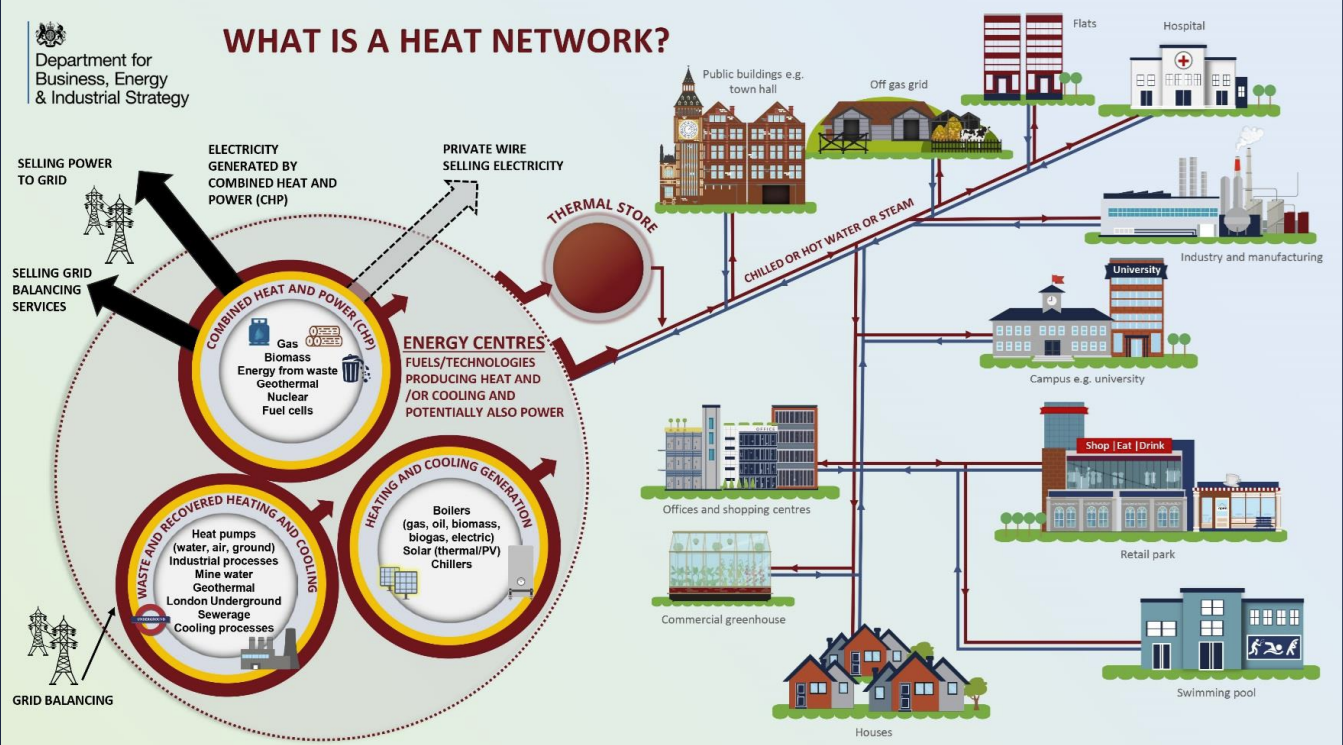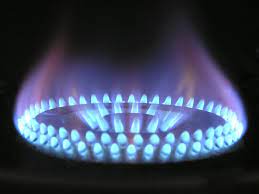What are heat networks?
Heat Networks are an alternative way of providing heating and hot water to buildings.
There are two types of heat networks; Firstly a large centralised plant that supplies heat to multiple buildings in the network, this is known as a district heating scheme, it can supply energy to everything connected in its location zone, such as homes, schools and commercial properties.
An excellent example of a district heating scheme which is currently under development is the Swan Partnership. A joint venture between Westminister Council and DESNZ. You can learn more about this scheme here.
The second kind is known as a communal heating system. This smaller heating system provides heat and hot water to a single block or small development. The heating system (or energy centre) is typically located in the plant room of the block and is usually run from commercial gas boilers or heat pumps. The thermal energy created by the energy centre runs from the plant room to each apartment through a series of pipes, providing the necessary heat to its occupants.
In densely populated urban areas, a property manager may find that their communal block, is eventually be migrated away from utilising its own energy centre and be connected to a larger district heating scheme. This is because more and more heat networks like Swan Heat are being developed to meet with the government’s targets for net zero. And if they can offer a more cost effective low carbon supply to residents, it makes sense for the communal heating system to be connected to the larger district heating scheme.
Heat networks provide a shared source of thermal energy (heating and hot water) to consumers. The heat is sold to the building occupiers by the heat supplier. Often it is the case that the heat supplier, appoints a billing agent to perform the task of billing occupiers on their behalf.
With older buildings, billing can be within the service charge (if there is no metering or its written into the lease) but for most new buildings billing for heat and hot water will be invoiced separate to service charge.

Who is the heat supplier?
The official definition is “A heat supplier is defined as any person or organisation that supplies and charges for the supply of heating, cooling or hot water to customers through a heat network”
While the heat supplier is the party responsible for billing consumers, the heat operator is responsible for maintaining the energy centre. Often, the same entity is responsible for both supply and operation.
The entities that take on these roles can be, building owners such as freeholders, landlords, enfranchised leaseholders, management companies or housing associations.
The most logical way to define the heat supplier, is they will typically be the entity liable to the energy centre’s fuel supplier.
Therefore, they must recover this cost from consumers who utilise the heat network.
The heat supplier will often delegate their responsibilities to their appointed property managing agents. The property managing agent, may subsequently appoint contractors to look after the maintenance and operation of the network, and also a different party to look after the billing and customer services requirements.
Why heat works, why now?
The UK Government has set a target for the UK to hit net zero emissions by 2050. 19% of UK carbon dioxide emissions came from buildings, of which 90% of which are residential. This means that transferring residential heating to a more energy-efficient system is crucial to reaching net zero emissions.
There are approximately 477,000 households (which is the equivalent to more than 1.1 million people) in the UK whose heating is provided by a heat network. The Government’s projection is that this will increase to 8 million people by 2030
Heat networks can be more energy efficient because they can run on thigs other than gas. For example they can run of, renewable electricity created from solar or hydro or even waste heat diverted from local sources.
Why are heat networks more energy efficient?
You may be wondering why heat networks are more energy efficient when they are often run from commercial gas boilers. The fact is, if your network is energy centre is run from a gas boiler, they won’t be low carbon or more energy efficient than a gas boiler. However, a key advantage of heat networks is their capacity to utilise waste heat from local sources, and tap into other renewable sources, promoting low-carbon and efficient energy use without relying on imported fuel.
This means in the future, the fuel the supplies the energy centre can be switched to a low cardon alternative, without the need to enter the apartments.
What are the benefits of heat network vs gas boiler apartments or electrical heating?
For block managers, there are some benefits to communal heating systems.
- Residents no longer have the responsibility of owning and operating a gas boiler. An energy centre run by a commercial organisation is safer than having multiple gas boilers installed and maintained by private individuals.
- When it is connected to a waste heat source or a renewable fuel, heat networks are more environmentally friendly than individual gas boilers.
- When it is connected to a waste heat source, heat networks can be more cost effective than individual gas boilers.
- Heat networks will almost certainly be more cost effective than heating an apartment through electrical heating as the cost of electricity can be three times more expensive than gas. While this is not a direct benefit for the property manager, it’s certainly a benefit they can communicate to residents.
What are the disadvantages of heat network vs individual gas boiler apartments or electrical heating?
For block managers, there are some disadvantages to communal heating systems.
- A communal heat network means it becomes the heat suppliers or their appointed property managers responsibility to maintain and operate the system.
- A communal heat network means it becomes the heat suppliers or their appointed property managers responsibility to invoice the consumers and provide the associated customer service and cash management services. Although its often the case that the property manager appoints a specialist company like Ginger Energy to take on this role on the heat suppliers’ behalf.
- A communal heat network means it becomes the heat suppliers or their appointed property managers responsibility to ensure that the relevant regulatory legislation relating to heat networks is followed.
- Due to unavoidable heat losses, heat networks are less efficient that a gas boiler. As a result, a consumer will likely receive a higher tariff charges for heat compared togas. This can create discontent.
In essence, the bullet points above means that the property owner or their appointed property manager to take on a role that is usually the responsibility of a licenced energy supplier, such as British Gas or Octopus Energy. Everything from ensuring continuity of supply and setting tariffs to providing billing and customer services.
What are the heat network responsibilities when running a heat network?
The Heat Network (Metering and Billing) Regulations outline how heat suppliers must supply and operate their heat networks.
If you are a property manager, its mostly like expected by your client, the heat supplier, that you will follow these rules on their behalf.
The only exception to this would be if your client has appointed an ESCo (Energy Services Company) to run the network on their behalf. However most small communal heating schemes will not be run by an ESCo and the property manager takes on the responsibility of compliance.
What happens if the network is not complaint?
The Energy Act 2023 has resulted in further legislation which is due from April 2025. Although full details of updated regulation is yet to be confirmed, we do know it’s to focus on consumer protection.
Ofgem’s role has been extended to become the regulator. As the regulator, they will help to ensure consumers get a fair price and reliable supply of heat, enforce current regulations and add new ones as necessary.
Citizens Advice are to be come the official advocacy and advice provider, and Ombudsman Services will provide the official Consumer Redress Scheme. In effect investigating complaints from consumers.
There will be a set of GSOP (Guaranteed Standards of Performance) around billing and customer service, and complaints handling, and a further set around technical standards.
Although the new legislation is yet to be released its thought that those heat suppliers that are found to be uncompliant will be given the opportunity to resolve the issues within a set time frame, or eventually enforcement will commence, and they may even fine the heat supplier. Heat suppliers may also be forced to pay compensation to residents.
What property managers must do in the here and now (before the revised regulation):
It important to understand that entities operating heat networks must ensure they follow the regulations, no matter what the lease says. This is because statutory regulation supersedes contractual law.
- Ensure heat networks comply with current Heat Network (Metering and Billing) Regulations.
- Invoice occupiers of metered properties in line with their energy consumption
- Submit notifications to OPSS to register each operated network every four years or when there has been a change in ownership.
- Ensure metering equipment is installed and is continuously operating (unless it can be evidenced that it is not commercially viable to do so – see next section)
How do I know if I should install metering equipment?
In November 2020, BEIS released the second part of the regulations introducing three building classes. Open, Viable or Except.
These classes allow heat network operators to define if they must install heat meters or heat cost allocators across their buildings.
If your building is exempt, you can continue to invoice on unmetered methods and do not have to install meters or cost allocators.
If heat meter or heat cost allocator installation is required, installation of all required devices was to be completed by 1 September 2022 and you are required to produce invoicing in line with The Heat Network (Metering and billing) (Amendment 2020) Regulations.
You can find out more about the classifications here.
Once you understand your buildings classification, if it is Open class, then you will need to complete the cost effectiveness assessment, and the excel tool for doing this is located on this page.
What else can I do to be regulation ready?
New regulations are focused on increased consumer protection. The regulations will cover;
- Standards of Conduct
- Fair Pricing
- Vulnerability
- Quality of service: (Complaints and Guaranteed Standards of Performance)
- Billing and Transparency
By following The Heat Trust guidance, you can cover most of these requirements.
If you have multiple networks, it’s worth analysing and comparing them against each other for their individual statistics, such as the average annual cost per apartment, complaint volume, frequency of outages. This will give you an indication of which networks may be cause for concern to the regulator.
High pricing can often be caused by either a expensive feed-in fuel tariff, or poor network efficiency or in many cases a combination of both.
What can I do to lower the cost of the heat tariff to residents?
Firstly
The easy win is to make sure the feed-in fuel contract is best value.
Most “landlord-supply” contracts, feed the energy to the communal areas only. Therefore, while identifying the best value contract is a consideration, it may not be of the highest of priorities.
However, a communal heat network uses the landlords-supply, so instead of costing a couple of thousand pounds per year, a heat network landlord-supply will cost tens of, if not, hundreds of thousands of pounds in fuel.
Therefore, the following the right procurement strategy, and securing the best value contract is of paramount importance. Half a penny in a contract, can result in thousands of pounds of unnecessary spend.
The energy markets are complex, products and suppliers for commercial landlord-supplies are varied. Add to that, the fact that many brokers are unscrupulous sales agents and will offer block managers what appears to be a great deal and headline price, which often has hidden costs written into the small print, can all result in residents paying unnecessarily high prices for their heat tariff.
Block managers should carefully consider any contract that is presented to them, and if unsure always get a second opinion.
Ginger Energy’s procurement team will at no cost, sanity check any quotes received for heat network block managers, to ensure the most appropriate, best fit, best value product has been identified.
After ensuring the feed-in fuel tariff is competitive, reviewing the networks heat losses should is essential. Ensuring your network is optimised and running efficiency is key to keeping heat tariffs low.
The CIBSE CP1 (2020) document states that a good network should operate with 70% efficiency.
The reality is that most heat networks in the UK operate at 30-40% efficiency, and for many networks there is scope for improvement.
Currently the government are encouraging heat suppliers and operators to apply for grant funding to diagnose and improve a networks performance to fall in line with CIBSE’s review.
Its important to understand that each network will have its only set of characteristics and the age, the size, and the infrastructure, of the network will have an impact on what efficiency rate can be achieved.
How can I get funding to optimise my network and thus reduce carbon emissions and ensure tariffs are lowered?
The UK government have pledged to invest £338 million by 2025, into the Heat Network Transformation Programme. As part of this programme, funding has been provided to public, private or third sector heat network projects across England and Wales through the Heat Network Efficiency Scheme (HNES). The Heat Network Efficiency Scheme (HNES) provides grant funding to support performance improvements to existing / operational district heating and communal heating projects.
If you need help with the application, please get in contact with Ginger Energy we can arrange a no win – no fee application on your behalf through our channel partners.
What is HNTAS?
The Energy Act 2023 provides the powers for government to mandate heat network technical standards through regulations.
Heat Network Technical Assurance Scheme (HNTAS) is due to launch in 2025 and aims to ensure that heat networks meet a minimum level of performance and reliability.
Many of these technical requirements build on the voluntary standards set out in CIBSE CP1 (2020). There is also a scheme of assessment and certification being developed to ensure heat network compliance with these technical requirements can be demonstrated. Together, these requirements and assurance processes form the Heat Network Technical Assurance Scheme (HNTAS).
Technical standards regulation will apply to heat networks from communal to city wide district systems, including both new build and existing legacy networks.



